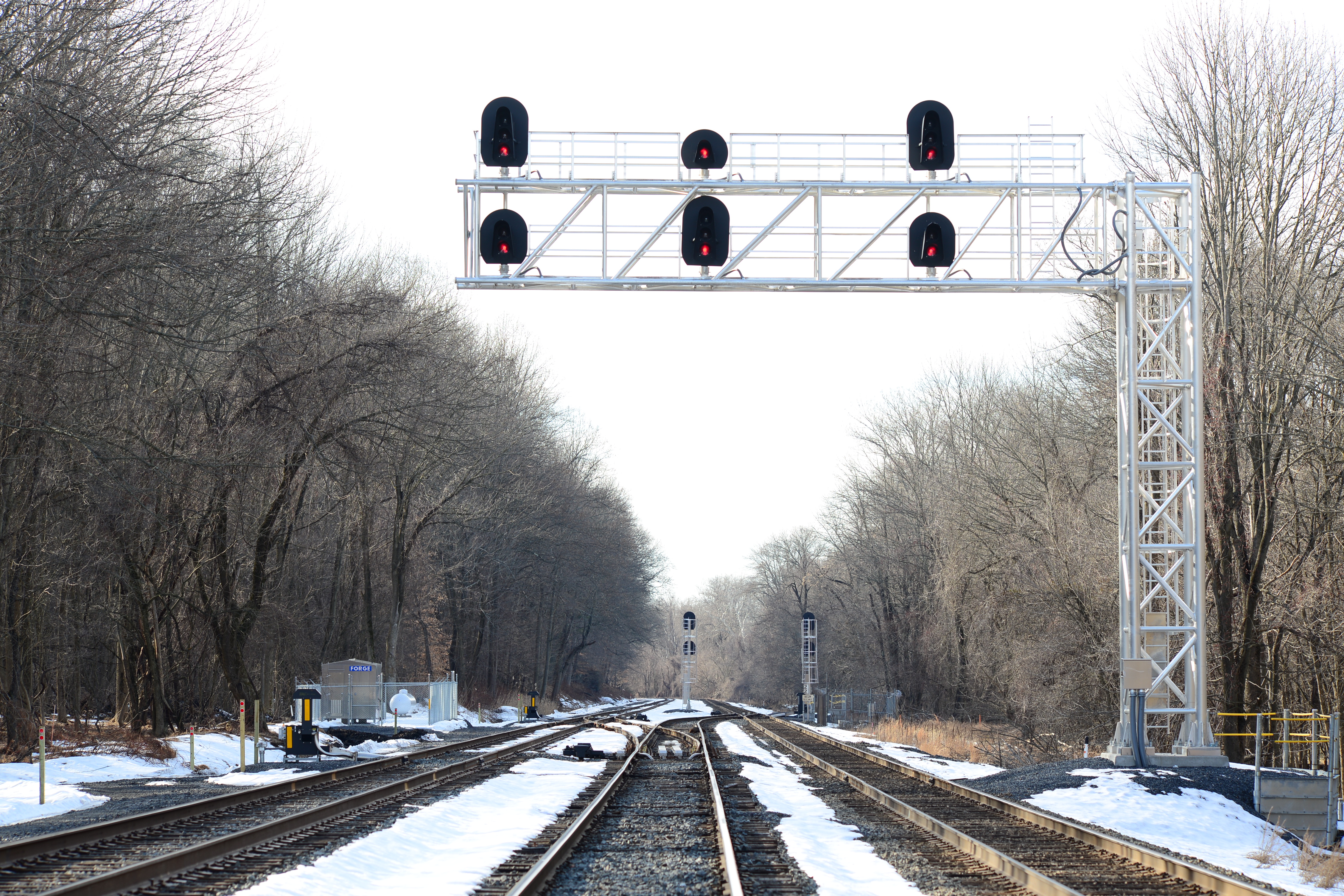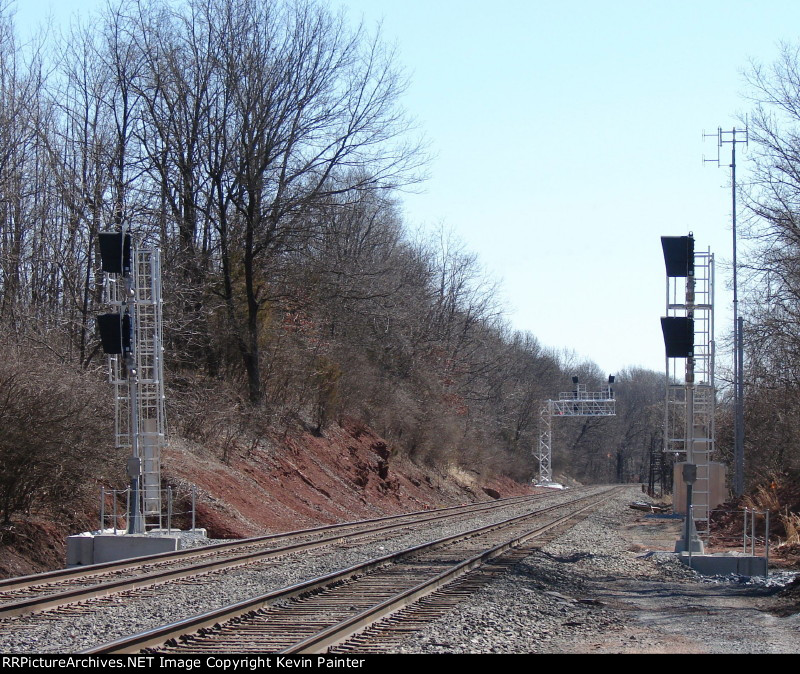I recently stumbled upon a YouTube channel run by an old Amtrak conductor who posted a number of video narrations of various parts of the Pennsylvania Tunnel and Terminal Railroad (Penn Station, Sunnyside Yard, etc) including the towers and signaling. The videos were shot prior to the mid-90's when the old towers and old signaling were still in place.
Here in this discussion of the Penn Station track layout, one can see some interrior footage of A Tower starting around 4:30
This video show Sunnyside Yard has some footage around Q tower a little past 3:30.
Here is another Sunnyside video with some Q tower content right up front and some R tower inside footage after 8:00
These are the ones with the most tower content, but her has a bunch of other tour videos that are still very interesting. Check them out!!!
A blog devoted to explaining the ins and outs of North American railroad signaling, past, present and future. This blog seeks to preserve through photo documentation the great diversity and technical ingenuity of 20th century signaling and interlocking hardware and technology. Related topics cover interlocking towers and railroad communications infrastructure.
Note, due to a web hosting failure some of the photos and links may be unavailable.
Search This Blog
Saturday, March 31, 2018
Tuesday, March 27, 2018
Here Comes the Harrisburg Line CTC Project
Well NS just cut in the CTC on the former Conrail Reading Line, however the original "Reading Line" was the Reading railroad Main Line between Philadelphia and Reading. Eventually folded into the Conrail Harrisburg Line, running between Philadelphia and Harrisburg, the western end was given the CTC treatment pretty much on the NS/CR border in 1999/2000. However, the portion between Reading and Philly was largely left in it's ABS Rule 251 State barring a few bits and pieces here and there.
NS has already gone about replacing most of the former Conrail ABS small target searchlights with Darth masts, and then embarked on a re-signaling project that has gone from CP-FALLS to CP-PHOENIX (exclusive). However a few searchlights and Rule 251 remnants hold on. Still, a new crossover is in evidence at CP-BIRD and just a few miles north of there a new crossover is going in at the future CP-LORANE.
The biggest loss, besides the whole concept of single direction ABS, will be CP-TITUS, which is pretty much still in it's 1960's Reading System configuration, complete with a movable point diamond. Needless to say, that i currently my top target for documentary preservation. Hopefully things will move slowly, as they did with the Reading Line, however one has to be prepared for the unexpected, like with the Allentown Terminal complex. Don't pass up the opportunity to get out there while you can.
 |
| The All New CP-FORGE |
The biggest loss, besides the whole concept of single direction ABS, will be CP-TITUS, which is pretty much still in it's 1960's Reading System configuration, complete with a movable point diamond. Needless to say, that i currently my top target for documentary preservation. Hopefully things will move slowly, as they did with the Reading Line, however one has to be prepared for the unexpected, like with the Allentown Terminal complex. Don't pass up the opportunity to get out there while you can.
Monday, March 19, 2018
NS Reading Line 261 Finally Cut In
Wow, so it took nearly 2 years, but the short, 30 mile long NS Reading Line has finally been "upgraded" to bi-directional Rule 261 operation, replacing the former Conrail small target searchlight signals. Fortunately, over the course of two marathon trips I was able to document most of the signals between CP-WEST LAUREL and CP-ALLEN, inclusive.
The Reading Line and I go way back, it being the site of one of my very first interlocking surveys all the way back in 2002 and later captured in this blog post on CP-ALBURTIS. I later surveyed the Reading Line from the back of an Amtrak fall foliage train in 2016, returning a few weeks later to document the west end and then about 6 months after that to cover the east end. Incidentally, the re-signaling will also come with an increase in speed from 50 to 60mph, with NS now making full use of its Class 4 track. Speed increases are rare events, even after a re-signaling effort as it requires the re-timing of every grade crossing on the route, whereas normally they can be left alone. This may have accounted for the protracted timeframe of the project.
I want to thank my friend Kevin, a Reading Line local, for being my guide and I want to direct everyone over to his own photo album of the signaling changes over the last 2 years. It's a damn shame to see another stretch of increasingly rare ABS bite the dust, but at least we did everything we could to capture what it was like.
The Reading Line and I go way back, it being the site of one of my very first interlocking surveys all the way back in 2002 and later captured in this blog post on CP-ALBURTIS. I later surveyed the Reading Line from the back of an Amtrak fall foliage train in 2016, returning a few weeks later to document the west end and then about 6 months after that to cover the east end. Incidentally, the re-signaling will also come with an increase in speed from 50 to 60mph, with NS now making full use of its Class 4 track. Speed increases are rare events, even after a re-signaling effort as it requires the re-timing of every grade crossing on the route, whereas normally they can be left alone. This may have accounted for the protracted timeframe of the project.
I want to thank my friend Kevin, a Reading Line local, for being my guide and I want to direct everyone over to his own photo album of the signaling changes over the last 2 years. It's a damn shame to see another stretch of increasingly rare ABS bite the dust, but at least we did everything we could to capture what it was like.
Sunday, March 11, 2018
Book Review: GRS - Elements of Railway Signaling
So it's come to this. I'm so desperate for filler content that I've taken a page from the Forgotten Weapons playbook and started posting book reviews 😂 General Railway Signal's (GRS) Elements of Railway Signaling (or at least this version) was published in 1979, on the 75th anniversary of the companies consolidation. It is an industrialreference book similar to Babcock and Wilcox's "Steam: It's Generation and Use" and is likely targeted at electrical engineers who are looking to enter the railway signaling field or at least manage it. No publisher information is listed and it appears to have no ISBN.
The book is exceedingly comprehensive, covering everything from basic track circuits to CTC systems and NX interlocking schemes. It also covers all sorts of obscure topics like approach lighting and hump yard retarder systems. When one reads the word "Basics" in a title, one might expect a focus on "basic" operations. Big easy to read diagrams of Automatic Block schemes and grade crossings. This book is more an inch deep and a mile wide, providing a basic explanation of pretty much every railroad signaling topic.
Ultimately this is where the book can fail a reader with no or only casual electrical engineering experience (and no, not the digital kind that everybody is learning today). For pretty much every signaling topic one can think of, the book provides a paragraph or two, a diagram and then moves on to the next topic. There has been very little effort given to actually trying to provide intuitive explanations and a lay reader will probably need to make more than a few passes.
Ultimately a reader will gain insight into why (classic) signaling works the way it does, however there are so many ways to do similar things that without further information one will not be able to tell how any specific piece of railroad is signaled. Moreover, with a date of 1979, there are a lot of things that are not covered like solid state relay replacements and data transmission that uses packets instead of simple frequencies and polarities. Still, it's a very valuable reference for anyone who is looking to understand how things worked in the pre-digital age and Railway Signaling is far more accessible than something like Color Television or Telephone Switches. After all, relays are pretty much digital devices.
Because of it's "not really published" status, the book is hard to find at typical online booksellers. Ebay is your best bet with final sales prices ranging between $20 and $30 before shipping. These books also can be found at train shows with a typical price of $40.
The book is exceedingly comprehensive, covering everything from basic track circuits to CTC systems and NX interlocking schemes. It also covers all sorts of obscure topics like approach lighting and hump yard retarder systems. When one reads the word "Basics" in a title, one might expect a focus on "basic" operations. Big easy to read diagrams of Automatic Block schemes and grade crossings. This book is more an inch deep and a mile wide, providing a basic explanation of pretty much every railroad signaling topic.
Ultimately this is where the book can fail a reader with no or only casual electrical engineering experience (and no, not the digital kind that everybody is learning today). For pretty much every signaling topic one can think of, the book provides a paragraph or two, a diagram and then moves on to the next topic. There has been very little effort given to actually trying to provide intuitive explanations and a lay reader will probably need to make more than a few passes.
Ultimately a reader will gain insight into why (classic) signaling works the way it does, however there are so many ways to do similar things that without further information one will not be able to tell how any specific piece of railroad is signaled. Moreover, with a date of 1979, there are a lot of things that are not covered like solid state relay replacements and data transmission that uses packets instead of simple frequencies and polarities. Still, it's a very valuable reference for anyone who is looking to understand how things worked in the pre-digital age and Railway Signaling is far more accessible than something like Color Television or Telephone Switches. After all, relays are pretty much digital devices.
Because of it's "not really published" status, the book is hard to find at typical online booksellers. Ebay is your best bet with final sales prices ranging between $20 and $30 before shipping. These books also can be found at train shows with a typical price of $40.
Subscribe to:
Posts (Atom)





